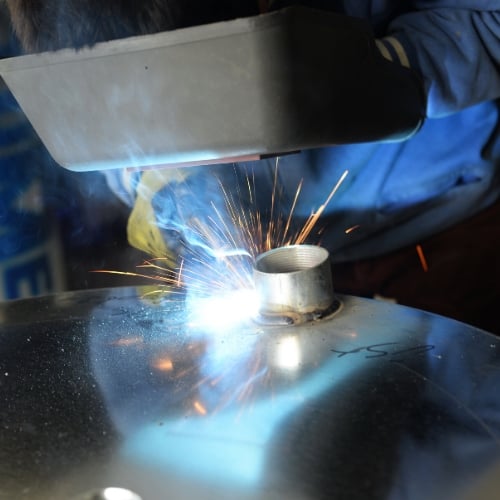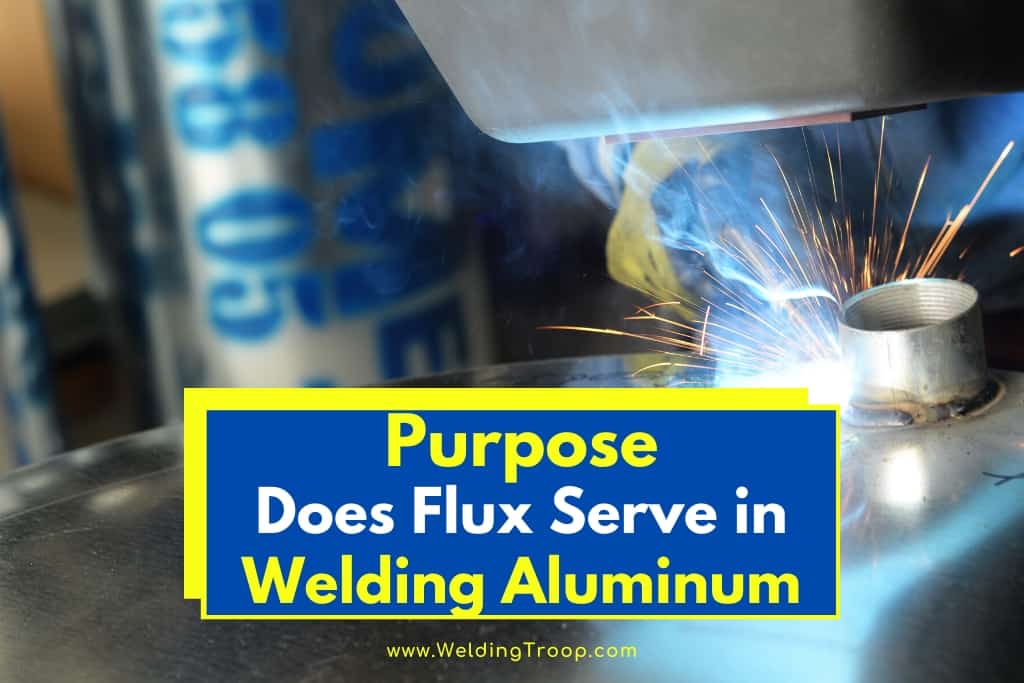Aluminum is a useful material in welding, especially for cold temperature applications, but it does come with some complex challenges, too. Many types of metal require some kind of shielding against oxidation to ensure a decent weld, but this is especially true of aluminum.
What purpose does flux serve in welding aluminum? Flux protects the aluminum from oxidation and atmospheric contamination from hydrogen or moisture. More-so than many other metals, aluminum is especially vulnerable to porosity problems and defects resulting from air-contaminated welds. Flux acts as a barrier between the molten weld and the air.
Flux is an integral part of many welding operations, but for aluminum, it is crucial. The chemical makeup of aluminum creates several unique challenges in using it as a metalworker. Read on to find out more about the purpose of flux and its application in welding aluminum.
Table of Contents
What is Flux?
In metallurgy, flux has many different functions, from chemical cleaning and purification to shielding. In the context of aluminum welding, flux is a solid-state substance that performs a variety of functions:
- Prevents penetration of atmospheric hydrogen
- Absorbs non-metallic inclusions and contaminants
- Removes dissolved hydrogen in the weld
- Allows for refinement in aluminum grain during the cooling process
- Prevents oxidation
- Oxidizes excess magnesium
The most common types of flux used in aluminum welding are mixtures of fluoride and chloride salts. In ancient times, a flux would have been created using charcoal, potash, or lime. But in modern metalworking, there is a wide variety of fluxes available that are customized to suit many different welding applications. Inert gas is another form of flux shielding used in aluminum welding.

Flux does remove some impurities from the aluminum during the weld, but many amateur welders are mistakenly under the impression that flux itself acts to clean the surface of the aluminum.
Instead, flux is meant to be applied after the aluminum has been thoroughly cleaned of grease, dirt, and any debris. Flux breaks down the aluminum oxide surface layer that forms on all aluminum surfaces as a result of oxidation.
What Is Flux? >> Check out the video below
Why Does Aluminum Require Flux?
Aluminum requires flux because of its chemical makeup. Aluminum is very reactive to atmospheric chemicals such as oxygen and hydrogen, causing it to form an aluminum oxide surface layer whenever it is exposed to the air.
Unlike oxygen, which has a low melting point, aluminum oxide has a very high melting point. With a coating of aluminum oxide, aluminum becomes next-to-impossible to weld correctly without damaging it at the molecular level.
The problem with having to overheat the aluminum during the welding process is that this can, in turn, char or burn the flux, leading to defects in the weld and an inconsistent visual appearance. A successful aluminum weld relies on making sure the weld is kept clean and that the flux is applied evenly afterward to prevent atmospheric exposure.

Another issue with aluminum is that it also has very high conductivity for heat. This means when aluminum is welded, care has to be taken to restrict the heat-affected area as much as possible to avoid distortion, melt-throughs, or other problems.
Related reading: 6 reasons why it is difficult to weld aluminum?
Why Does Oxidation Ruin a Weld Without Flux?
Without flux to protect it during the welding process, aluminum is vulnerable to contamination from the surrounding atmosphere. That leads to the following issues with the resulting weld:
- Physical defects: Oxidation can cause the weld to take on an uneven or spattered consistency, which is a severe fault in industrial welding applications that must pass inspection.
- Porosity: Oxidation causes welds to retain dissolved hydrogen that forms bubbles in the weld during the solidification process, weakening the assembly at the joint by causing it to become hollowed out from within.
- Penetration: Once an aluminum surface has oxidized, this means that it will require much higher levels of heat to melt the surface layer of the aluminum. In thin sheets of aluminum, this can sometimes cause the welding torch to burn through the weld completely.
- Heat affectation: Exposing aluminum to high heat for more extended periods increases the amount of surrounding metal that is affected by the high temperatures the weld is generating.
This heat affectation can crop up later as brittleness in the metal surrounding the joint, or surface distortion.
The key to a successful aluminum weld is being able to move the weld along quickly and smoothly at as low of a temperature as possible. Once the aluminum has oxidized, the increased melting point of the surface layer of the aluminum prevents this smooth welding operation from taking place.

What Flux Should You Use for Aluminum?
There are many welding fluxes available on the market for aluminum that are suited to several kinds of aluminum welding applications. Here are a few of the fluxes that you might consider to properly prepare an aluminum weld depending on what type of welding technique you’re using:
- Forney 37025 Aluminum Welding Flux
- Harris SCAF4 Stay Clean Alum Soldering Flux
- Hot Max 24184 Aluminum Brazing Flux for Welding
No matter what kind of welding you’re doing, there is an aluminum flux on the market that will give you what you need to make sure your weld turns out. Even though welding aluminum can be complicated by its chemistry, knowing how the metallurgy of welding aluminum works can help you prevent the environmental factors that lead to problems during the weld.
If you’re not sure which aluminum flux is a good fit for your project, it’s a good idea to check in at your local welding supply shop or an online aluminum welding forum to see what other welders recommend for the job. While you should always take opinions off the Internet with a grain of salt, it’s a good idea to do a little background research before committing to a particular kind of flux.
Related reading: Can You Weld Aluminum Without Gas? Is It Possible?
Can You Weld Aluminum with Steel-Based Core Flux Wire?
The answer is no. Core flux wire is specially designed for steel welding applications and is not designed to be used with aluminum welding. The only core flux wire available for aluminum applications are found in aluminum soldering.
A better alternative to trying to weld with wire flux and aluminum is to braze the aluminum joint using a propane torch and a gas flux shield. Without a gas shield, soldering is also another way to avoid having to perform a full weld. Soldering aluminum is only feasible for some kinds of specific repair jobs or as a rigging method to smooth over minor cracks, holes, and other defects.
Other Tips for Welding Aluminum
When you’re welding aluminum, there are a few core concepts you should understand and practice to achieve a good result. Here are some ways to improve your aluminum welding:
- Make sure the base aluminum is clean and has had the external layer of aluminum scrubbed away at the weld site using a wire brush.
- Remove flux after the weld has solidified. If the flux is left at the weld site, it can cause corrosion and performance issues in the joint later down the road.
- Make sure aluminum sheeting is appropriately stored. Vertical storage prevents the accumulation of water, and aluminum is best stored indoors in temperature-controlled conditions for optimal welding results.
- Never weld without protective equipment. It might seem worth it to skip the trouble of throwing on welding gloves or squinting through a quick arc weld without a visor, but looking at an arc flash can cause permanent damage to your eyesight, and welding gloves prevent severe third-degree burns as a result of welding spatter or slag.
Aluminum is an exotic metal and can be somewhat tricky to manipulate as a welder, but being meticulous in how you prepare and set up the weld makes a significant difference in the outcome.
Related reading: Do You Need a Spool Gun to Weld Aluminum?
Flux Serves a Necessary Purpose in Aluminum Welding
Whether shielding the weld with an inert gas or by forming a protective barrier on the surface of the metal itself, flux is crucial to aluminum welding to prevent the many welding problems that can arise working with this temperamental form of metal. The same properties that make it an asset in cold weather applications cause severe issues in high-temperature ones.
No matter if you’re doing aluminum welding as a home project or you’re pursuing it professionally, an aluminum welding project needs flux for a successful result.
Sources:
https://www.harrisproductsgroup.com/en/blog/2016/june/five-misconceptions-about-flux.aspx
https://www.substech.com/dokuwiki/doku.php?id=fluxes_for_melting_aluminum
https://www.instructables.com/community/Can-I-weld-aluminum-with-a-mig-welder-if-I-have-fl/
https://en.wikipedia.org/wiki/Flux_(metallurgy)
https://www.metalsupermarkets.com/tips-for-welding-aluminum/
https://superiorflux.com/role-of-flux/
https://www.tinmantech.com/faqs/welding-FAQs/alumaloy-vs-rods-and-flux.php
https://www.thefabricator.com/thefabricator/article/aluminumwelding/understanding-aluminum-welding-compared-to-steel-welding

